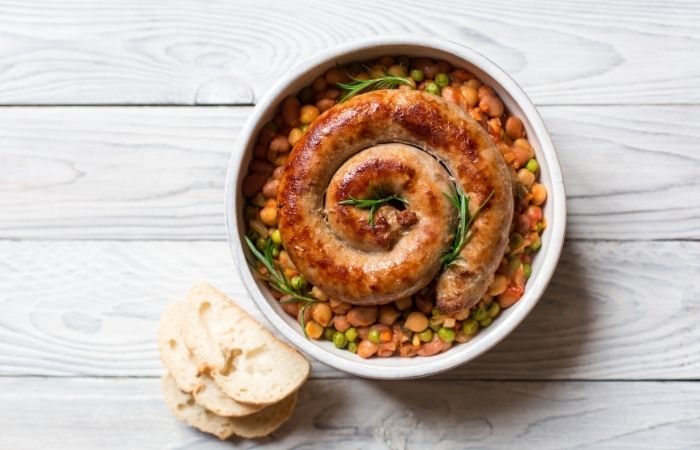What is Italian Sausage?
Anyone looking for directions on how to cook Italian sausage will inevitably wind up asking how to make Italian sausage as well. This is because all chefs and home cooks know that part of the joy of cooking is learning how to incorporate certain ingredients as well.

In this case, we will try to define what Italian sausage is, to alleviate any possible doubts about its appropriateness, in the Italian cooking tradition. Your immersion in the fine art of making and cooking great Italian sausage begins now.
Italian sausage is made up of raw ground pork with some seasoning added to the mix. The ground pork is then stuffed into “skins” until each skin is full of the mixture. The result is raw Italian sausage that is ready to be cooked, or stored in the freezer for a future cooking session.
How to Cook Italian Sausage- Three Ways
You may cook your masterpiece either in the oven, on a pan on your stove, or grilled over a hot fire. The result should always be that the Italian sausage will be seared first on the outside to brown them nicely.
You may then continue cooking them until the internal temp of Italian sausage reaches approximately 71.2 degrees Celsius (160 degrees Fahrenheit). This is necessary so that the raw pork within the skins will thoroughly cook. Undercooking the sausage will affect the taste, plus may breed bacteria that can be toxic when ingested by people.
The time used to cook each Italian sausage is very important. If the heat you use to cook is too hot, you might wind up charring the sausage skin. But the inner pork filling would be undercooked. The result? Lousy sausages that are only good for feeding your cat or dog, or worse, tossed into the garbage bin instead.
Should You Pierce the Skin?
It isn’t a good idea to pierce the outer skin of an Italian sausage because the flavorful juices of the sausage would escape. Although this might be what some cooks desire, the truth is that it would be better to just cook each Italian sausage as is, without poking holes in the skin.

The liquid within each Italian sausage is important because it will convey heat within the skins to reach even the innermost part. That way, you won’t have to worry that you’ll be serving half-cooked, half-raw sausages.
Why You’ll Love Cooking Italian Sausage
Some skeptics may ask why you should try cooking a batch of either homemade or store-bought Italian sausage. We would like to point out that learning how to make Italian sausage is not just art in itself. Rather, it will teach you the value of thrift since homemade Italian sausages are cheaper yet more nutritious than their store-bought counterparts.
You can also improve your cooking skills if you opt to make your own Italian sausages. You’ll be able to do trial and error when you experiment with the ingredients.
Yes, there’s the risk that your first batch of sausages could wind up tasting weird, but that’s part of the chef’s game. Just note down which ingredients you could reduce or increase until you come up with the best recipe you’ve ever tried to make.
Once you’ve cooked a batch of Italian sausages, you may notice that there could be leftovers if you cooked a lot. Don’t throw these away! You can recycle leftover Italian sausage as ingredients for future meals. You’ll be pleasantly surprised by how tasty a dish can be when you add leftover Italian sausage to it.
Our Top Italian Sausage Cooking Tips
Many cooks are probably more familiar with cooking sausages on the stove or baked within their oven. Not everyone knows how to grill sausages, though. So here are some tips that will allow you to cook perfect Italian sausages every time.
How to Cook Italian Sausage on Stove Top
To cook Italian sausage on the stove, you need a frying pan or skillet that doesn’t heat up too fast. You should have brought out your Italian sausage pack from the freezer earlier so that each sausage isn’t frozen in the middle when cooked. You can add a little oil to the pan so that you can sear each sausage first.
Once the skin is nice and brown, you can add around one cup of water to the pan. (That’s 236.59 milliliters.) Cover the pan and let the sausages simmer for around 10 minutes over a medium-hot fire. Make sure you don’t poke holes in the skins, as mentioned earlier.
You may notice that fat and liquid will be released from the cooking sausages as you keep cooking them. Don’t remove these since these are important for adding flavor to the sausages. Soon, your Italian sausage feast will be ready to eat!
How to Cook Italian Sausage in Oven
You will find that this is the healthiest way to cook your Italian sausage because there’s not much cooking oil used compared to frying. You will be baking the sausages. As long as you use the right temperature for cooking these, your Italian sausage experiment should be successful.
You need an oven whose internal temperature can go to 177 degrees Celsius (350 degrees Fahrenheit.) Put the raw links on an oven-proof casserole or a baking sheet. If necessary, you may use aluminum foil beneath the sausages since this encourages heat retention.
Cook in the oven for up to 35 minutes. If in doubt, use a meat thermometer to check the internal temperature, which should be at 71 degrees Celsius (160 degrees Fahrenheit.)
Some might prefer to sear each Italian sausage in a pan to brown the skins before putting these into the oven. That’s actually a good idea since you will notice that the skins will be crunchy and crispy, yet the internal filling will still be juicy. Just make sure you monitor the sausages in the oven to avoid overcooking them.
How Long to Cook Italian Sausage on Grill
Remember that we advised you not to prick the skin of each Italian sausage? That’s especially important if you will be grilling the sausages since the rich liquid flavor would drain out of each link if you prick them.

It is equally critical not to use an extremely high temperature if you choose to grill Italian sausages. You may be risking burning the exterior of each sausage yet leaving the middle part raw. Therefore, it is advisable to use 204 to 218 degrees Celsius (400 to 425 degrees Fahrenheit) for six minutes when grilling a batch.
Be mindful and keep turning each sausage to get cooked to about the same finish on any part. This is one of the more tedious aspects of cooking Italian sausage. Still, you will be rewarded with perfectly-cooked sausages that can be proudly settled within the proper buns and with your preferred toppings. Dig in!
FAQs on Cooking Italian Sausage
What Can I Serve with Italian Sausages?
Don’t be surprised to learn that side dishes go well with your Italian sausage meal. Nowadays, many people have learned about the right kind of side dishes and how they can bump up your Italian sausage meal to a higher level.
One popular meal is Italian sausage, peppers, and onions. By sauteeing peppers and onions, you are cooking them so that their natural sweetness is amplified. You’re probably going to salivate at the thought of this side dish the next time you’re inspired to cook an Italian sausage or two.
Baked beans are another excellent dish to serve alongside your Italian sausages. If you’re preparing a lot of links, such as when you’re having a backyard barbecue, you can always prepare the baked beans via slow-cooker beforehand. The beans themselves could be pre-soaked in water the night before to make the cooking time shorter.
Should You Boil Italian Sausages Before Cooking Them?
It is acceptable to boil an Italian sausage rather than prepare it over the stove, in an oven, or by grilling. However, be clear as to what you’re expecting the final product to look like. Your Italian sausage will not be crunchy and crispy if you opt to boil it.
One advantage brought by boiling is that the Italian sausage will be well-cooked inside and out. But you might be disappointed by the taste, which is different from the sausage taste from stove-top or oven cooking. And naturally, the boiled sausage will not look anything like a grilled sausage. If this is acceptable, then go for it!
Nutritional Facts on Italian Sausages
We all know by now that an Italian sausage is packed full of flavor, making it an appealing component of any dish. However, some may question its nutritional value because it has hardly any vitamins and minerals in it. It also has a lot of fat due to the ground pork we have added into the filling.
But don’t fret- your Italian sausage does have 14 grams (396.9 ounces) of protein in it. Surprisingly, there is also a lot of potassium, accounting for 7% of the sausage’s nutritional value.
If you’re concerned about upping the nutritional value of your meal, you can prepare side salads and roasted veggies as well. This really helps, as long as these options pack on the necessary vitamins and minerals alongside your Italian sausage.
The key is to strike a happy balance between the meat and the veggies. Of course, raw fruit as dessert will be great too.
Italian Sausage, Pepper and Onion Skillet
If you really want to try infusing Italian sausage into your diet, here is one recipe that you might like to try out.
Time: 25 minutes
Serving Size: 4 servings
Prep Time: 10 minutes
Cook Time: 15 minutes
Equipment Needed
- Gas or electric stove
- One medium-sized cast iron skillet or frying pan
- One sharp knife
- One cutting board
Ingredients
- 2 cups onions. You can take your pick between two red or two white onions. Yellow onions are a suitable substitute for either
- 2 teaspoons olive oil
- 1 pound Italian sausages. Ideally, you need sugar-free and preservative-free sausages. You will need these to be raw. If you only have frozen Italian sausages on hand, just thaw those as well.
- 3 cloves garlic – fresh and thinly sliced.
- 3 bell peppers – color preference is up to you, but three different colors are advised. These make the dish look more cheerful and festive.
- ¼ teaspoon chili flakes.
- ¾ teaspoon salt.
- ½ teaspoon pepper.
- 2 tablespoons chopped basil leaves.
- Butter (optional)
- Ghee (optional)
- Red wine (optional)- You only need ½ cup. You can substitute chicken broth or apple cider for this one instead, provided you aren’t restricted to whole30 or low-carb dietary programs.
- Parsley for serving (optional).
Directions
- You can use a regular-sized frying pan for cooking this dish.
- Slice the onions thinly. Then set aside.
- Slice the peppers as thinly as you’d prefer. Set aside.
- Heat the pan or skillet over medium heat.
- Add the olive oil to the heated pan, just enough to cook the sausages. Make sure each link is well-browned, though not necessarily cooked through. This may take two to three minutes.
- Slice each semi-cooked sausage into bite-sized pieces. Set aside.
- You may put in more olive oil or add butter or ghee if you feel it is necessary.
- Saute the sliced onions, then add the peppers.
- You may carefully season the dish now with salt, pepper, and chili flakes.
- You may then add the red wine, apple cider, or chicken broth (whichever strikes your fancy) to the onions and peppers in the skillet. There will be some brown bits of sausage at the bottom of the pan so you can mix around the liquid with a ladle so that the brown bits will be cooking with the liquid. This step is dubbed “deglazing” and adds flavor to the dish.
- You may add the sausage slices to the pan as well. Lower the heat to medium and cover the pan. The contents will then simmer for another 10 minutes at that heat.
- Remove the cover and let the dish simmer more at medium-high heat for another three minutes, or until the liquid has reduced and the sausages are fully cooked.
- If you have a meat thermometer ready, you may use this to check if the sausages are done.
- You may serve the dish with chopped basil and parsley leaves. Enjoy!
How to Know When Your Italian Sausages are Ready
For seasoned cooks and chefs, it is a no-brainer to find out when each Italian sausage is ready to serve. They will slice off and taste a portion. This is the best way since your eyes may be misled by the browned skin.
However, if you can’t taste the Italian sausage (such as when cooking for guests or running a restaurant), you can always use a meat thermometer to insert into the link. The internal temperature of every sausage should be at 71 degrees Celsius (160 degrees Fahrenheit.)
Cooking Italian sausages isn’t that difficult if you’re paying attention to what you’re doing. The great part is that you won’t need to stress about it because eventually, you will master the cooking process.
You can then ask friends and family over for sausage parties in your backyard or over the kitchen table. That should be something to look forward to for any fledgling cook.

Community of passionate writers and content creators who share a love for Italian heritage, culture, travel, food, and the Italian-American community. Our mission is to celebrate Italy’s rich history and traditions and connect with others who share the same passion.

